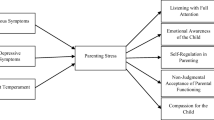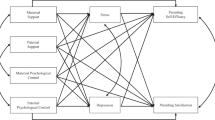Abstract
The aim of this study was to develop a model to explain the factors influencing parenting stress in mothers of premature infants, and to verify the appropriateness of the model. The exogenous variables consisted of infant temperament and maternal positive psychological capital (PsyCap). Endogenous variables consisted of parenting efficacy and parenting stress. The participants included 233 mothers of premature infants, with a corrected age under 24 months. Data were collected from March to September 2013, using self-reported questionnaires. The model fit indices suggested that the original hypothesized model adequately fit the data. The final model accounted for 39 % of the variance in parenting stress. Furthermore, we found that parenting stress was directly and indirectly affected by infant temperament, and their mother’s positive PsyCap via parenting efficacy. Premature infant’s negative emotionality was moderately related to higher parenting efficacy and lower parenting stress. Mother’s positive PsyCap directly affected parenting efficacy and parenting, and indirectly affected parenting stress through parenting efficacy. Furthermore, parenting efficacy directly affected parenting stress. These results suggest that nursing strategies based on the parent–child interaction model are needed for promoting positive maternal mental health and parenting efficacy, to reduce parenting stress in mothers of premature infants.



Similar content being viewed by others
References
Abidin, R. R. (1990). Parenting stress index-short form. Charlotteville, VA: Pediatric Psychology Press.
Ahn, R. L., & Kim, J. A. (2005). The relationship between mother’s parenting efficacy, parenting stress, children’s daily stress, and peer competence. Journal of Educational Studies, 36(1), 329–350.
Ahn, J. Y., & Park, S. Y. (2002). The effect of maternal parental beliefs, efficacy and stress on mother’s parenting behaviors. Journal of the Korean Home Economics Association, 40(1), 1–16.
Anzman-Frasca, S., Stifter, C. A., Paul, I. M., & Birch, L. L. (2013). Infant temperament and maternal parenting self-efficacy predict child weight outcomes. Infant Behavior and Development, 36, 494–497. doi:10.1016/j.infbeh.2013.04.006.
Bacharach, V. R., & Baumeister, A. A. (1998). Effects of maternal intelligence, marital status, income, and home environment on cognitive development of low birth weight infants. Journal of Pediatric Psychology, 23(3), 197–205.
Bakeman, R., & Brown, J. V. (1980). Early interaction: Consequences for social and mental development at three years. Child Developement, 51, 37–447.
Baker, B., McGrath, J. M., Pickler, R., Jallo, N., & Cohen, S. (2013). Competence and responsiveness in mothers of late preterm infants versus term infants. Journal of Obstetric, Gynecologic, and Neonatal Nursing, 42(3), 301–310. doi:10.1111/1552-6909.12026.
Bandura, A. (1977). Social learning theory. Oxford: Prentice-Hall.
Bang, K. S., Kim, Y. S., & Park, J. W. (2003). Study on the comparison of emotion between the mothers with low-birth weights and normal infants and the effect of home visiting for the low-birth weights. Korean Parent–Child Health Journal, 5(1), 75–89.
Barnard, K. E. (1997). Influencing parent-child interactions for children at risk, the effectiveness of early intervention edited by Guralnick (pp. 249–268). Baltimore, MD: M.J. Paul H Books Publishing Co.
Belsky, J., & Barends, N. (2002). Personality and parenting. In M. H. Bornstein (Ed.), Handbook of parenting: Vol. 3. Being and becoming a parent (2nd ed., pp. 415–438). Mahwah, NJ: Erlbaum.
Browne, M. W., & Cudeck, R. (1993). Alternative ways of assessing model fit. In K. A. Bollen & J. S. Long (Eds.), Testing structural equation models (pp. 136–162). Beverly Hills, CA: Sage.
Bruder-Costello, B., Warner, V., Talati, A., Nomura, Y., Bruder, G., & Weissman, M. (2007). Temperament among offspring at high and low risk for depression. Psychiatry Research, 153, 145–151. doi:10.1016/j.psychres.2007.02.013.
Buss, A. H., & Plomin, R. (1984). Temperament: Early developing personality traits. Hillsdale, NJ: Lawrence Erlbaum Associates.
Coplan, R. J., Reichel, M., & Rowan, K. (2009). Exploring the associations between maternal personality, child temperament, and parenting: A focus on emotions. Personality and Individual Differences, 46, 241–246. doi:10.1016/j.paid.2008.10.011.
Essex, M. J., Klein, M. H., Cho, E., & Kalin, N. H. (2002). Maternal stress beginning in infancy may sensitize children to later stress exposure: Effects on cortisol and behavior. Society of Biological Psychiatry, 52, 776–784.
Gefland, D. M., Teti, D. M., & Fox, C. R. (1992). Sources of parenting stress for depressed and nondepressed mothers of infants. Journal of Clinical Child Psychology, 21, 262–272.
Gennaro, S., Tulman, L., & Fawcett, J. (1990). Temperament in preterm and fullterm infants at three and six months of age. Merrill-Palmer Quarterly, 36, 201–215.
Gray, P. H., Edwards, D. M., O’Callagha, M. J., & Cuskelly, M. (2012). Parenting stress in mothers of preterm infants during early infancy. Early Human Developemt, 88, 45–49. doi:10.1016/j.earlhumdev.2011.06.014.
Halpern, L. F., Brand, K. L., & Malone, A. F. (2001). Parenting stress in mothers of very-low-birthweight (VLBW) and full term infants: A function of infant behavioral characteristics and child rearing attitudes. Journal of Pediatric Psychology, 26, 93–104. doi:10.1093/jpepsy/26.2.93.
Han, K. J., Bang, K. S., & Kwon, M. K. (2010). Parent–child health and nursing (p. 65). Seoul: Hyunmoonsa.
Holditch-Davis, D., White-Traut, R. C., Levy, J. A., O’Shea, T. M., Geraldo, V., & David, R. J. (2014). Maternally administered interventions for preterm infants in the NICU: Effects on maternal psychological distress and mother–infant relationship. Infant Behavior and Development, 37(4), 695–710. doi:10.1016/j.infbeh.2014.08.
Hu, L., & Bentler, P. M. (1999). Cutoff criteria for fit indexes in covariance structure analysis: Conventional criteria versus new alternatives. A Multidisciplinary Journal, 6(1), 1–55. doi:10.1080/10705519909540118.
Hughes, M. B., Shults, J., McGrath, J., & Medokff-Cooper, B. (2002). Temperament characteristics of premature infants in the first year of life. Journal of Developmental and Behavioral Pediatrics, 23(6), 430–435.
Jang, Y. J., & Lee, K. Y. (2014). A study on the longitudinal relationship between mothers` negative emotions and the emotional temperament of infants using an adapted autoregressive cross-lagged model. Journal of Early Childhood Education, 34(3), 67–84.
Kaaresen, P. I., Rønning, J. A., Ulvund, S. E., & Dahl, L. B. (2006). A randomized controlled trial of the effectiveness of an early-intervention program in reducing parenting stress after preterm birth. Pediatrics, 118(1), e9–19. doi:10.1542/peds.2005-1491.
Kagan, J., Snidman, N., McManis, M., Woodward, S., & Hardway, C. (2002). One measure, one meaning: Multiple measures, clearer meaning. Development and Psychopathology, 14(3), 463–475.
Kenner, C., & Lott, J. W. (1990). Parent transition after discharge from the NICU. Neonatal Network, 9(2), 31–37.
Kim, K. H., & Kang, H. K. (1997). Development of the parenting stress scale. Family and Environment Research, 35(5), 141–150.
Kline, R. (2010). Principles and practice of structural equation modeling. New York: The Guilford Press.
Korea Institute for Health and Social Affairs (2009). Congenital anomaly survey and statistics, Policy paper, 2009-62. https://www.kihasa.re.kr/html/jsp/publication/policy/view.jsp?bid=12&ano=549&key=ryear&query=&ryear_value=2009&content_type=1&queryString=cnllYXJfdmFsdWU9MjAwOSZrZXk9cnllYXImcnllYXI9MjAwOSZxdWVyeT0mcGFnZT0zJmRpdmlzaW9uPeygleyxheuztOqzoOyEnA==, Retrieved at October 2014.
Korea Institute of Child Care and Education (2009). Korea child panel instruments profile 2009. http://kicce.re.kr/panel/bbs_board/board_view.jsp?board_no=0202&seq=345&page_num=1&menu_id=0404&board_type=A, Retrieved at June 17, 2012.
KOSIS. http://kosis.kr/. Accessed 20 Jan 2012.
Kwon, M. K. (2011). Parenting stress and related factors of employed and non-employed mothers with infants. Journal of Korean Child Care and Education, 7(2), 19–41.
La Marca-Ghaemmaghami, P., La Marca, R., Dainese, S. M., Haller, M., Zimmermann, R., & Ehlert, U. (2013). The association between perceived emotional support, maternal mood, salivary cortisol, salivary cortisone, and the ratio between the two compounds in response to acute stress in second trimester pregnant women. Journal of Psychosomatic Research, 75, 314–320. doi:10.1016/j.jpsychores.2013.08.010.
Langkamp, D. L., Kim, Y., & Pascoe, J. M. (1998). Temperament of preterm infants at 4 months of age: Maternal ratings and perceptions. Journal of Developmental and Behavioral Pediatrics, 19, 391–395.
Lee, S. W., Jeon, S. I., Kim, Y. M., Lee, J. H., Choi, Y. M., & Lee, G. C. (1998). The relationship between depressive tendency in postpartum women and factors such as infant temperament, parenting stress and coping style. Journal of Korean Neuropsychiatric Association, 37(1), 95–103.
Lee, J. S., & Moon, H. J. (2009). The relationships between positive maternal psychology, internal-external control, and parenting stress of mothers with young children. Journal of the Korean Home Economics Association, 47(4), 37–48.
Luthans, F., Avey, J. B., Avolio, B. J., Norman, S. M., & Combs, G. M. (2006). Psychological capital development: Toward a micro-intervention. Journal of Organizational Behavior, 27, 387–393. doi:10.1002/job.373.
Macedo, A., Marques, M., Bos, S., Maia, B. R., Pereira, R., Soares, M. J., et al. (2011). Mother’s personality and infant temperament. Infant Behavior & Development, 34, 552–568.
McGrath, J., Records, R., & Rice, M. (2008). Maternal depression and infant temperament characteristics. Infant Behavior and Development, 31(1), 71–80. doi:10.1016/j.infbeh.2007.07.001.
Medoff-Cooper, B. (1986). Temperament in very low birth weight infants. Nursing Research, 35, 139–143.
Moon, H. J. (2004). Parenting stress of employed and unemployed mothers. Journal of the Korean Home Economics Association, 42(11), 109–122.
Nicolaou, M., Rosewella, R., Marlow, N., & Glazebrook, C. (2009). Mothers’ experiences of interacting with their premature infants. Journal of Reproductive and Infant Psychology, 27(2), 182–194.
Oestberg, M., & Hagekull, B. (2000). A structural modeling approach to the understanding of parenting stress. Journal of Clinical Child Psychology, 29(4), 615–625.
Park, J. A., Shin, Y. L., & Rhee, M. R. (2013). Risk and protective factors of risk and non-risk infant development: Using data mining approach. Journal of Early Childhood Education, 33(1), 31–46.
Pauli-Pott, U., Mertesacker, B., Bade, U., Bauer, C., & Beckmann, D. (2000). Contexts of relations of infant negative emotionality to caregiver’s reactivity/sensitivity. Infant Behavior and Development, 23, 23–39.
Porter, C. L., & Hsu, H. C. (2003). First-time mothers’ perceptions of efficacy during the transition to motherhood: Links to infant temperament. Journal of Family Psychology, 17(1), 54–64. doi:10.1037/0893-3200.17.1.54.
Sanders, M. R., Cann, W., & Markie-Dadds, C. (2003). The triple p positive parent programme: A universial population-level approach to the prevention of child abuse. Child Abuse Review, 12, 155–171. doi:10.1002/car.708.
Schofield, T. J., Conger, R. D., Brent Donnellan, D. M., Jochem, R., Widaman, K. F., & Conger, K. J. (2012). Parent Personality and Positive Parenting as Predictors of Positive Adolescent Personality Development Over Time. Merrill-Palmer Quarterly, 58(2), 255–283. doi:10.1353/mpq.2012.0008.
Singer, L. T., Fulton, S., Kirchner, H. L., Eisengart, S., Lewis, B., Short, E., et al. (2010). Longitudinal predictors of maternal stress and coping after very low-birth-weight birth. Archives of Pediatrics and Adolescent Medicine, 164(6), 518–524. doi:10.1001/archpediatrics.2010.81.
Spungen, L. B., & Farran, A. C. (1986). Effect of intensive care unit exposure on temperament in low birth weight preterm infants. Journal of Developmental and Behavioral Pediatrics, 7, 288–292.
Tucker, L. R., & Lewis, C. (1973). A reliability coefficient for maximum likelihood factor analysis. Psychometrika, 38, 1–10.
Verhage, M. L., Oosterman, M., & Schuengel, C. (2013). Parenting self-efficacy predicts perceptions of infant negative temperament characteristics. Journal of Family Psychology, 27(5), 844–849. doi:10.1037/a0034263.
Voellmin, A., Entringer, S., Moog, N., Wadhwa, P. D., & Buss, C. (2013). Maternal positive affect over the course of pregnancy is associated with the length of gestation and reduced risk of preterm delivery. Journal of Psychosomatic Research, 75, 336–340. doi:10.1016/j.jpsychores.2013.06.031.
Yeonhab News (2013). Tough country to raise kids; Korea lowest birthrate world. http://www.yonhapnews.co.kr/economy/2014/06/13/0301000000AKR20140613158200008. Accessed 30 Sep 2014.
Yoo, H. S. (2005). Focusing on women’s human, social and psychological capitals: A study on the actual conditions and utilization of women’s capital. Journal of Asian Women, 44(2), 225–259.
Acknowledgments
We wish to thank all the assistants of the development clinic and the health care centers. Most importantly, we extend our deepest appreciation to the mothers who shared their information and experiences about parenting preterm babies.
Funding
This research was supported by the Basic Science Research Program through the National Research Foundation of Korea (NRF) funded by the Ministry of Education, Science, and Technology (NRF-2012R1A1A1042025).
Author information
Authors and Affiliations
Corresponding author
Rights and permissions
About this article
Cite this article
Yu, M., Kim, K.E. A Structural Equation Model for Parenting Stress in Mothers of Premature Infants. J Child Fam Stud 25, 1334–1344 (2016). https://doi.org/10.1007/s10826-015-0297-1
Published:
Issue Date:
DOI: https://doi.org/10.1007/s10826-015-0297-1




